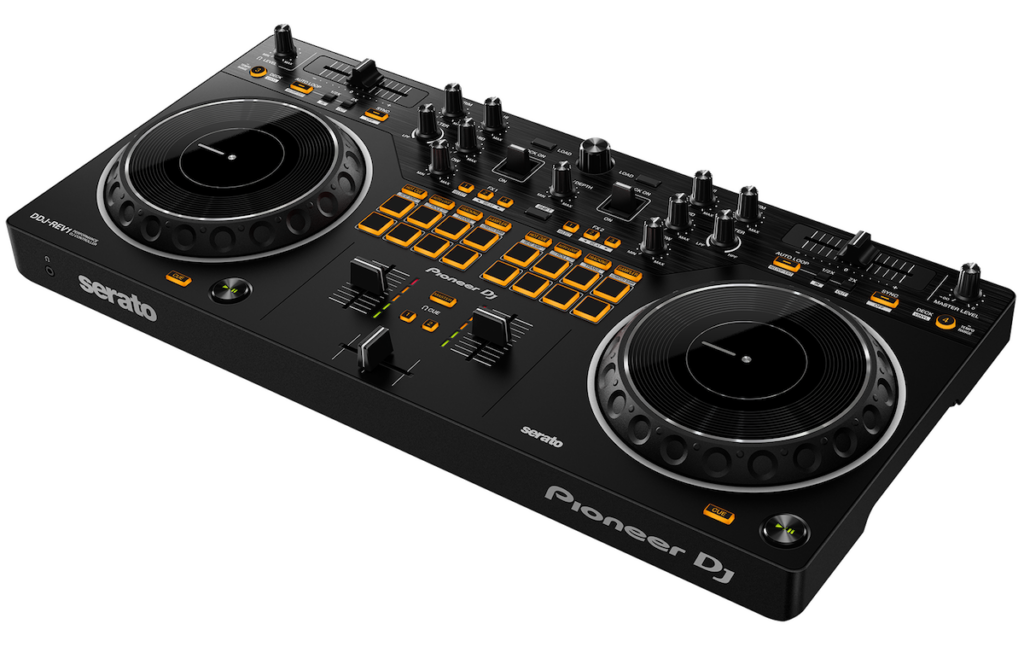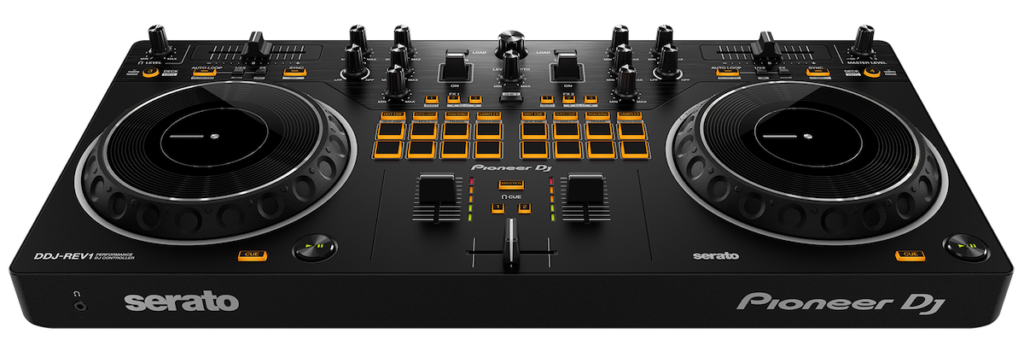An alternative to the hugely popular DDJ-400, the REV1 offers a unique feel which will appeal to a certain type of DJ. Greg Scarth finds out what sets it apart.

Pioneer’s DDJ-400 is one of the most popular entry-level DJ controllers on the market. It hits the sweet spot of being simple enough for beginners to use while being powerful enough for more serious DJs who want a portable backup controller or something to practise on at home. With this, the new Pioneer DDJ-REV1, the brand introduce a new model which sits at the same kind of price and might seem like broadly the same thing: they’re both two-channel controllers with all Pioneer’s usual features. The key difference is one of attitude rather than capabilities. The REV1 is still a controller, but it’s one which is aimed at performers, eclectic multi-genre mixers and scratch DJs.
Everywhere you look, there are touches that differentiate the REV1 from other controllers aimed at traditional mix-and-blend DJs. The most obvious comparison is with the DDJ-400, which comes in at the same price as the REV1. The two controllers are very similar in size, with the REV1 coming in slightly bigger left-to-right and slightly smaller front-to-back. It’s only a matter of a few centimetres, but the wider, shallower format allows for larger jog wheels, which are placed right at the front of the unit to become the main focus in terms of control.

The DDJ-400 and REV1 might seem similar in terms of specs, but upon closer inspection, the two models share only one thing in terms of layout: the placement of the crossfader. Everything else – literally everything – is different in some way, from the subtle things like the insertion of the headphone cue buttons in between the channel faders, through to the more obvious changes like those larger, more prominent jog wheels, the ‘battle-style’ placement of the pitch faders right at the top of the unit and the performance pads in the mixer section.

The DDJ-400 works with Pioneer’s own Rekordbox DJ software, but the REV1 is designed for compatibility with Serato DJ, which is hugely popular with turntablists. A free version, Serato DJ Lite, is available to get you started (as your skills progress, you can subscribe to the full Serato DJ Pro version from $9.99 per month, or buy a licence outright if you prefer). Getting started is as easy as it gets: download and install the software, connect the REV1 to your laptop with a USB cable (which also provides the power) and hook the stereo RCA outputs up to a suitable amp or speakers. Plug in your headphones round the front and you’re good to go.

The one thing that’s immediately clear is that this isn’t just a lazy tweak of an existing model in an attempt to pass it off as a new product. Pioneer describe the REV1 as a ‘scratch-style’ controller but we’d actually say it’s a bit more versatile than that. Like its bigger brother, the DDJ-REV7, the REV1 encourages you to perform in different ways.In terms of developing the REV1 and REV7 to work for scratch DJs and other performance DJs, Pioneer have made some big changes inspired by some of the flagship products in their range. The mixer sections of both controllers clearly draw on the DJM-S11 scratch mixer, with the emphasis on performance pads rather than EQs. The pads on the REV1 are smaller than those on the S11 but still feel good and allow you to access hot cues, samples, the Scratch Bank and the Tracking Scratch feature, which automatically jumps the track back to a defined cue point when you release the jog wheel.

The dual effects sections are also a real strong point of the REV1, with the effects levers allowing you to enhance performances by engaging effects temporarily or locking them on separately for each deck. For those who want to scratch, it’s worth noting that the jog wheels are not only better placed than those on the DDJ-400 but also larger, with the handy inclusion of a position marker so you can visually observe the rotation of the platter. In vinyl mode, they’re responsive and offer a nice feel when scratching.
The biggest rival to the DDJ-REV1 is Pioneer’s own DDJ-400, which leaves the final questions: who is the REV1 for, and why would you choose it over the DDJ-400? Most obviously, the REV1 will appeal to people who want to scratch as part of their DJ sets. It would also work well for anyone who considers themself a performer rather than just a mixer. You can still mix with the REV1 just as you would with any other DDJ (although the pitch fader placement makes it slightly more fiddly) but you’ll get the most out of it if you embrace the options to trigger samples, scratch and use effects. Finally, the REV1 will appeal to people who want to play lots of genres in a set. The powerful effects sections help immensely when transitioning in tempos and styles. All in all, the REV1 is a worthy alternative to the DDJ-400, aimed at a slightly different type of DJ but just as capable and just as good value.
Greg Scarth
More info/buy